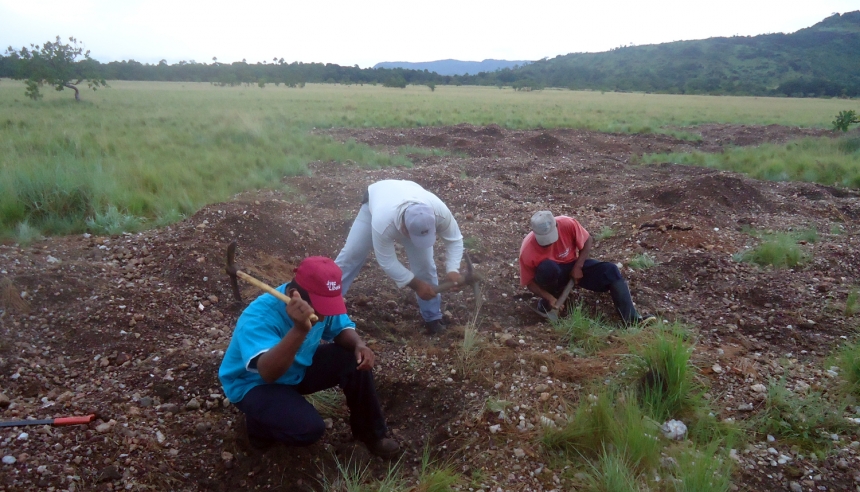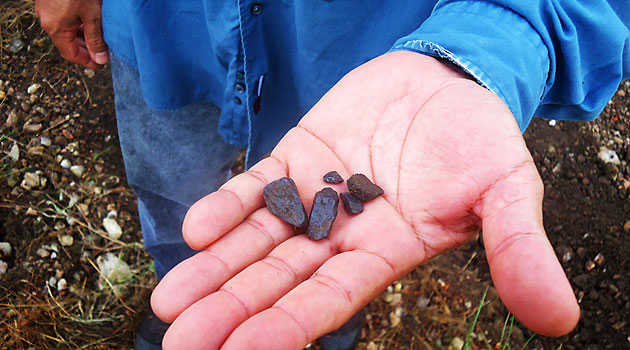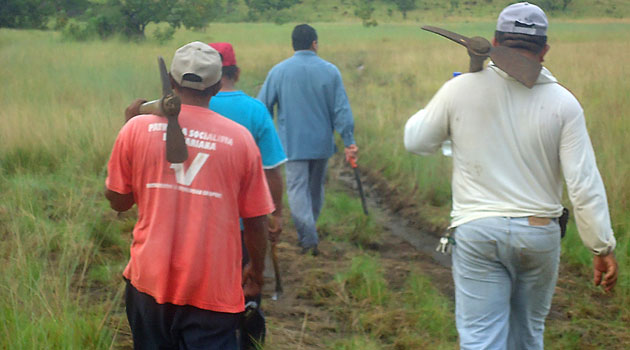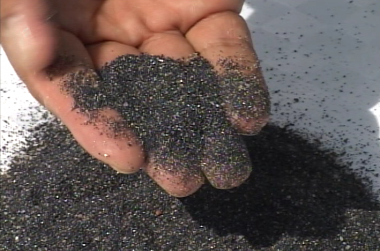On a narrow trail muddied by rain, a slight man in a thin T-shirt emerges from the thick of a remote jungle, down where Colombia ends and Venezuela and Brazil begin. He’s striding quickly, despite nearly 50 pounds of rocks inside a woven basket, anchored to his back by a white cloth wrapped around his forehead.
“Yes, I’m coming from the mine,” the man says, the weight of the basket preventing him from looking up at strangers he’s encountered on the trail, inside Puinawai National Park. He’s part of a local Indian tribe and is moving precious ore in the same palm-frond baskets his ancestors once weaved to bring prey home from a hunt.
The miner has little time to talk; the drop-off point for his ore is still miles away, outside the park.
Closer to the mine, near a stream, men briskly shovel muddy mounds of small rocks onto screens, then pour water over them to expose what they hope are pebbles containing tungsten or coltan. And at the mine itself, men, women and small children dig holes and sift through mud in search of ore.
This is an illegal mine, on a plot of land stripped of trees and surrounded by pristine jungle.
The work here goes on well out of the view of Colombian police patrols looking for traffickers moving contraband ore containing valuable minerals like coltan and tungsten.
“We are seeing the emergence of illegal groups engaged in mining activities, especially in rare-earth [minerals] in the eastern part of Colombia, very distant and remote areas in which mining is illegal,” said Mauricio Cárdenas, chief of Colombia’s Mining Ministry. These groups are “a national security concern for us.”
It’s proof, he said, that a black market for valuable metals and rare-earth minerals is growing in territory the Colombian government has historically found difficult to police. Not only is this mine inside a national preserve, but it’s tucked in a corner of Colombia infamous for drug smugglers and armed paramilitaries.
Cárdenas had just seen a video, recorded by the International Consortium of Investigative Journalists, in which miners scratch at the ground in search of what industry experts call “vitamins” for global high-tech manufacturers of microchips and controls that enhance growing numbers of smart phones and other consumer electronics.
These miners are collecting what can be considered “conflict minerals,” thus not just violating Colombian law, but potentially breaking international trade rules set by the United Nations.
What Cárdenas and others fear is that minerals smuggled from Colombia are making their way into the legitimate flow of minerals that feeds high-tech manufacturers. Illegal mining and smuggling have led to human-rights abuses against vulnerable tribal members, activists say. And police fear that it’s creating yet another illicit, profitable business for the region’s drug traffickers and well-armed paramilitaries.
Ultimately, the black market could also garner a label of “conflict minerals” for Colombian exports — a tattoo that has turned similar material from Central Africa into international contraband. For example, the U.S. government’s Dodd-Frank Act of 2010 prohibits American firms from buying natural resources obtained illegally or in areas controlled by criminals or terrorists.
Cocaine and coltan
In the late 19th century, Alexander Von Humboldt was the first outsider to map this part of the Amazon watershed. He found two rivers with reddish water, the Inírida and the Guaviare, where they empty into the dark waters of the Atabapo River and become the Rio Negro in Brazil. Today it’s the home for hundreds of fish species and South America’s largest sanctuary for endangered river dolphins.

The region is part of South America’s Guiana Shield which cuts across the continent’s northern arc. It’s a geologic sibling to the Sub-Saharan Shield in Africa. The local port town of Inírida takes its name from a native flower that has close relatives in Central Africa. Geologists say meteor strikes and strong river currents over millions of years have left rich mineral deposits near the surface.
This is where ICIJ and Colombia’s Noticias Uno television program got a rare glimpse of illicit mining in a part of Colombia’s Amazon jungle that’s hard for outsiders to penetrate.
Reporters found Puinawai Indians working the illegal mineral mine, a site first seen from the air as a bald, brown patch cut out of verdant jungle near the tribe’s sacred landmark, Mount Puinawai.
Mine workers told ICIJ that guerrillas control the mine, armed paramilitaries control the path they must take to the Guaviare River and narco-trafficking gangs transport the mineral. Guerrillas demand payment before a mine can be worked, paramilitaries want money before a load of sand and rock can be washed in the river, and then traffickers demand the ore be delivered to them miles away, outside of the park’s boundaries.
ICIJ interviewed police and soldiers in the area who are on the hunt for smugglers hauling illicit tungsten from local mines or coltan from across the border in Venezuela.
“The illegal minerals flow to and from Venezuela in pangas [motor boats] and upriver to Colombian side,” said Guainía state Police Commander William Ruiz. From Colombia, he added, coltan goes around the world.
Black-market coltan in the wilds of southeast Colombia has also captured the attention of U.S. law enforcement officials because of a connection to one of the world’s most powerful drug cartels.
Near Puinawai National Park, police said, an illicit operation mining coltan and other precious metals is run by members of the Cifuentes Villa family. In indictments filed in U.S. federal court, anti-drug authorities say fugitive members of the family supply cocaine to Mexico’s Joaquín Guzmán Loera — known as “El Chapo” (“Shortie”) — and his Sinaloa drug cartel.
In placing a myriad of Cifuentes Villa operations on its drug kingpin list, the U.S. Department of the Treasury made the clan’s mining business off-limits to Americans. U.S. officials called the mining company a money-laundering operation in support of a cocaine-smuggling enterprise.
Colombian authorities have also moved against the family, pulling its license to mine an area where 83 tons of coltan and tungsten ore have been seized since 2010.
“What we have found is that very sophisticated drug trafficking organizations are becoming more and more involved on minerals traffic from Puinawai Park and Venezuela, as it is documented on the judiciary files in an ongoing investigation,” Col. Alfredo de Vivero, the Colombian military commander in the area, told ICIJ.
Despite decades of interdiction operations by Colombian security forces and American military advisers, rules in this region are still often dictated either by right-wing paramilitaries or by rebels-turned-drug dealers in the Armed Revolutionary Forces of Colombia, the FARC.
De Videro said traffickers have coerced whole families from the Puinawai tribe to work the mines, or lured them with free beer, food and brand-name athletic shoes.
“Since [smugglers] invaded the territory of the indigenous community, the community denounced them, and since then we keep watch over the area to see to it that there is no illegal mining,” police commander Ruiz said as he gave a tour of his trophy — about four acres of barren land, bearing evidence of mining activity, confiscated in a recent raid.
Tracing minerals
Colombian police are also looking closely at a cache of tungsten ore captured last September in the middle of the Guaviare River in the Colombian state of Guainia, on the edge of Puinawai National Park.
“One of the problems we are having is that in these areas, there are some small titles, legally granted, that are being used as safe havens for the legalization of [illegal] activities,” Mining Minister Cárdenas said.
In 1995 Rafael Alberto Rodríguez Forero won the right to exploit a plot called El Caney de los Cristales, near the national park and the Guaviare River. Over the years, according to the licenses issued to him, he’s mined sand for building blocks, then “black sands,” a hint that he’d found veins of valuable minerals. In February 2006 Rodríguez started mining for iron and titanium.
In August 2010 he sought permits to move minerals via the river to the regional port Inírida, or to Bogotá. And in January 2011, Rodríguez Forero filled out Colombian tax forms to facilitate the export of tungsten to warehouses in Strassen, Luxembourg, belonging to Traxys Europe SA.
A middleman’s report said the tungsten that Traxys bought came from Rodríguez Forero’s mine near the Guaviare River and Puinawai Natural National Park. Ore from outside the national park is legal if a miner has a permit.
On Sept. 16, 2011 a Colombian military patrol seized 17 tons of tungsten ore in the middle of the river. Officials determined that the ore had been mined inside the park, at a site called El Zancudo.
According to a Colombian law enforcement source, an analysis of the seized ore indicates the tungsten from El Zancudo bears mineral concentrations similar to what Traxys purchased. Colombian officials said the government continues to investigate the origins of the two ore loads, but that Traxys is not suspected of any wrongdoing and Rodríguez Forero does not face any charges in the matter.
Rodríguez Forero holds the only mining permit in this area. In public statements he has denied responsibility for the seized ore, saying he was not responsible “for the improper use” of his licenses. He has urged authorities to step up patrols for the “rigorous monitoring of the ore that is brought to market in this criminal form.”
Rodríguez Forero, and Colombia-based Geocopper Company, which facilitated the Traxys purchase, declined repeated requests for comment from ICIJ. In a written response, Traxys said it had “no knowledge or involvement whatsoever in the confiscated material,” and that the minerals it purchased from Colombia came from entities that are “totally legitimate, properly licensed, and governmentally vetted.” The company also indicated that the ore it acquired came from an area some distance from Puinawai National Park.
Industry experts said questions over the origins of ore show how hard it is to keep conflict minerals out of high-tech industry supply lines.
“Unless big manufacturers or processors buy via long-term contracts, for example from Mozambique, Australia or Canada, they can never be entirely sure where their ore is coming from,” said coltan mining expert Michael Nest. “Global supply chains are complex and mix up ore from all over the place because processors and manufacturers have huge economies of scale — they need to mix up different batches of ore to improve efficiency.”
In 2009, Traxys, one of the world’s biggest processors of minerals for high-tech manufacturing, announced it was suspending purchases of coltan from war-torn Central Africa. Smuggling there is the target of human rights campaigns aimed at stopping armed groups from taking coltan to Rwanda, where it’s relabeled and sold to smelters worldwide.
Mining in a “red zone”
Rodríguez Forero has no criminal record and there are no charges pending against him in the tungsten investigation.
But controversy has surrounded Rodríguez Forero’s operation because his mines are deep in a territory thick with armed FARC units and anti-communist paramilitaries.
According to the Colombian government, the area “has been designated a red zone or area with high risk of danger for persons from outside the region, who are subject to extortion, kidnapping, and murder by organizations operating outside the law.”
In 1992 a police headquarters in the area was attacked by insurgents who killed four officers. The police abandoned the area and the FARC became the law. In 1997, paramilitaries struck back with the infamous Mapiripán massacre, beheading 47 people and disrupting the FARC’s cocaine production.
After the raid, authorities said the drug trafficker Carlos Mario Jiménez Naranjo purchased control of the area from paramilitaries in order to protect his smuggling business. But Colombian authorities arrested Jiménez and in 2008 handed him over to U.S. officials who wanted him on drug-trafficking charges. He pleaded guilty and was sentenced last May to 33 years in federal prison.
Jiménez’s role in illicit minerals smuggling has emerged from Colombia’s ongoing “Parapolitics” scandal — an investigation into ties between politicans, mining officials and paramilitaries.
ICIJ found that on Rodríguez Forero’s mining license the name Mario Jiménez was on the first line listing the property’s owners. Officials of Colombia’s Geological Service said the listing was a mistake, part of inaccuracies in the federal mine registry that have prompted its overhaul.
Since last fall’s ore seizures, Rodríguez Forero has obtained a certificate from local military leaders saying the area he mines is partially free of guerrillas and criminal gangs. If the Dodd-Frank Act restrictions were applied to South American mineral mining, the FARC’s listing as a terrorist organization by U.S. officials might present a problem for legitimate miners in the region.
In June 2010, a certificate issued by the Colombian army’s Fourth Division said troops in the area “are carrying out in-depth offensive operations continuously in these sectors … keeping the narco-terrorist groups of the FARC and [other criminal bands] on the run.”
Because of the suspicious activities and mining practices that threaten Puinawai tribal land and national parks, it is clear that allowing some small-scale mining in the region was a mistake, said Colombia’s former Environment Minister Manuel Rodríguez.
From 2005 to 2009, before the government could even finish mapping the area, mining rights were auctioned off to people who were not required to prove that they knew how to mine. There were so many claims that an illegal market for processing of titles was created.
Amid the chaos, the market for mining equipment also took off. For example, X-ray spectrometers that read mineral compositions in ore have become so common in Colombia’s mining regions that police have mistaken them for weapons.
Puinawai Indians say the devices are indeed guns, pointed at the earth beneath their sacred mountain.



